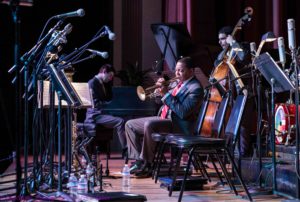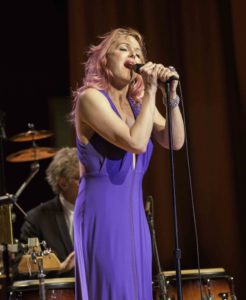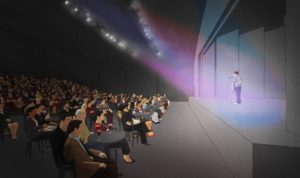The Center for the Arts’ plan for a dynamic, $3.8 million makeover
 FRESH FROM HELPING NEVADA COUNTY become a prestigious state Cultural District, The Center for the Arts in Grass Valley is launching its first-ever capital campaign to transform its downtown facility into a dynamic, state-of-the-art performance center that maintains an intimate ambiance, our magazine has learned.
FRESH FROM HELPING NEVADA COUNTY become a prestigious state Cultural District, The Center for the Arts in Grass Valley is launching its first-ever capital campaign to transform its downtown facility into a dynamic, state-of-the-art performance center that maintains an intimate ambiance, our magazine has learned.
The improvements, estimated to cost $3.8 million, will help cement western Nevada County as a destination for the arts, drawing visitors and locals for generations to come.
“It will greatly improve the audience and artist experience,” says Amber Jo Manuel, The Center’s interim executive director and director of development since fall 2016.
The renovation is set to begin early next year and be completed by year-end 2018, just in time for a celebratory New Year’s Eve gala. The enterprising plan is being closely managed to stay on budget, with an experienced team of staffers, board members and community stakeholders.
The project will add 200 seats, offer more comfortable seating, a bigger stage, state-of-the-art sound and lighting, more energy efficient heating, ventilation and air conditioning (HVAC), ADA compliance, and repair roofing, among other improvements.
The campaign is benefitting from the community’s passion for the arts, and it includes a grassroots fundraiser planned for spring. Donors will be offered naming opportunities throughout the venue, including the building itself.
The renovation is needed. The building, donated to The Center in 2003, faces $500,000 in deferred maintenance, and it demands a more modern space.
 The Center has presented a wide range of world-renowned performers, including Joan Baez, Jeff Bridges, Jackson Browne, Judy Collins, Melissa Etheridge, Michael Franti, Wynonna Judd, Willie Nelson, and Wynton Marsalis.
The Center has presented a wide range of world-renowned performers, including Joan Baez, Jeff Bridges, Jackson Browne, Judy Collins, Melissa Etheridge, Michael Franti, Wynonna Judd, Willie Nelson, and Wynton Marsalis.
It has presented speakers such as food activists Alice Waters and Michael Pollan, and Mt. Everest mountain climber Melissa Arnot. And it has introduced up-and-coming talent, including Rising Appalachia, Birds of Chicago, and Las Cafeteras.
The Center has won the prestigious FestForums’ Innovation Award for California WorldFest, presented by the organizer of Woodstock. It also has helped make western Nevada County an exciting venue for the arts, drawing patrons from all over Northern California and Northern Nevada.
 Executive Director Julie Baker retired this summer after eight years of leadership, and helped draw world-class performers to Grass Valley. She is launching her own consulting firm, Julie Baker Projects, and will continue to support The Center. “Julie worked hard to bring high quality programming to our community,” says Board President Betsy Swann Brown.
Executive Director Julie Baker retired this summer after eight years of leadership, and helped draw world-class performers to Grass Valley. She is launching her own consulting firm, Julie Baker Projects, and will continue to support The Center. “Julie worked hard to bring high quality programming to our community,” says Board President Betsy Swann Brown.
Manuel will lead the Center as it embarks on this new chapter, and she is well qualified for the role. A native of Nevada County, Amber Jo worked the past 17 years in marketing and development for nonprofit arts groups in the Bay Area and New York City.
Before joining The Center last fall, she led a $33 million capital campaign for San Francisco’s American Conservatory Theater’s second stage, The Strand Theater, which opened in May 2015.
Prior to ACT, Manuel was involved with capital campaign fundraising and development efforts at both California Academy of Sciences and Berkeley Repertory Theater. In New York, Amber Jo held the title of Individual Giving Director at the Roundabout Theater.
She and the board have built an experienced local team to renovate The Center for the Arts building. KVMR board member Diane McIntire, a general contractor, designer and project manager, has helped manage the project.
The local team of Tru-Line Builders, whose owner is Daniel Swartzendruber, and Brent Daggett Architect/Planner were chosen to handle the project in a competitive process.
The contractor and architect have been working together with the project manager since the beginning to manage the budget and alleviate delivery problems using the “integrated project delivery” (IPD) approach. Under IPD, the architect, general contractor and the client work together to complete a project that is on time and on budget.
Grass Valley is supporting the project, discussing plans for expanded downtown parking as well as shuttle busses to and from The Center during performances. The city’s Mayor Howard Levine is an artist and innkeeper, and he believes the project will build community and boost business downtown.
We had a “sneak peek” at The Center’s new floor plans. Guests arrive at the front entrance at 314 W. Main Street, and walk past the box office into a refreshed 1,500 sq.-ft. welcome lobby with new offices, a conference room, and expanded bathrooms on one side, and concessions and an expanded bar area on the other side.
They pass an art gallery on the way into the auditorium, which has a new orientation. Patrons walk into the back of the auditorium rather than one side. From the rear entrance, they face a new stage, which extends past the existing building to make room for more seats.
The auditorium’s seating plan allows for flexibility depending on the show. Patrons will no longer have to cross in front of the stage during performances to access the lounge or the lobby.
Retractable seating allows The Center to host concerts that require fixed seating, a dance floor or cabaret seating—or various combinations. The expansion also adds potential for banquet rentals for gala events. By increasing the seating, The Center will be less dependent on renting outside venues and will be able to expand its mission in its own home.
Examples could include seating for up to 506 patrons; tiered seating with cabaret (262 seats, plus cabaret seating for another 172 people); and tiered seating with dance (262 seats and substantial room for people to dance).
The stage is about 2,000 sq.-ft. The plans also include a much-improved backstage area for artists, such as two additional “green rooms” (for the artists), a dressing room, a rest room, shower and storage area.
“The Center’s capital campaign is not only an investment in the building, but will allow The Center to continue to grow a sustainable business while ensuring its legacy as the performing arts institution of Nevada County,” according to a donor brochure.
NEW SOUND
The Center’s improvements will include a state-of-the-art Meyer Sound System. Berkeley-based Meyer Sound founders John and Helen Meyer are global audio pioneers. They make a range of high-end audio products, and are known for their ability to enhance, through electronic means, the acoustic of a concert hall or auditorium.
Francis Ford Coppola hired Meyer Sound to build subwoofers for a custom sound system for movie theaters screening Apocalypse Now, putting the “whomp” into explosions and helicopter rotors.
“Meyer systems are becoming a fixture of the classical world, from the Bay Area to Berlin,” according to The New Yorker. “The system can give bloom to a somewhat dry acoustic, as at Zellerbach Hall, in Berkeley, and it can supply a cleaner sound for amplified jazz and pop, as at Svetlanov Hall, in Moscow.”
NEW SEATING
Center’s current seats were salvaged from a ’50s movie theater and are almost 75 years old. New retractable seating will increase comfort and flexibility. The Center will soon display a prototype of the new seats in its welcome lobby. The new seating plan will allow The Center to book more “big name talent” in a more enjoyable setting than the Vets Hall. The theater will remain intimate with no seat more than 59 feet from the stage.
For more information about The Center’s capital campaign, visit TheCenterForTheArts.org/contact-us or call 530-274-8384. This article appears in the fall issue of Sierra FoodWineArt magazine. A digital version is HERE.
(Photo: Angel Aguilar, John Taber, Brent Daggett Architects)

